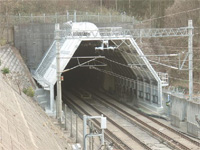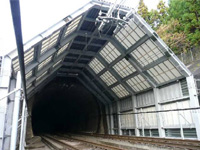 |
 |
 |
Increasing Shinkansen Train Speeds (Development of Ground Facilities and Structural Technologies to Meet Environmental Standards)  |
We are progressing with R&D on increasing Shinkansen speed to achieve further high-speed transport. Environmental measures also need to be taken, however, in order to meet environmental standards. Those involve both measures for rolling stock and those for ground facilities.
|
New tunnel hoods |
 |
 |
 |
 |
 |
 |
| Tunnel hood with ducts |
|
Tunnel hood made of lightweight panels |
|
 |
|
|
 |
When high-speed trains enter tunnels, the compression waves in the air formed with the rapid increase in pressure are transmitted to the tunnel exit, sometimes creating an explosive sound at the exit. To restrain that sudden increase in pressure, a tunnel-shaped structure a size larger than the tunnel cross section is installed at the tunnel entrance. That structure is called a tunnel hood. Construction conditions are poor around most tunnel entrances and exits, and the hood has to be built from above the track, causing construction expenses for hoods to be high. For that reason, we are conducting development on tunnel hoods that can be installed at lower cost than those with previous technologies.
| (1) |
Tunnel hoods with ducts
We have worked to achieve lower-cost construction by adding chimney-shaped ducts that allow for shorter tunnel hood extension. |
| (2) |
Light panel tunnel hoods
The goal of this development is to be able to build tunnel hoods at low cost. By developing highly durable and light large panels of film materials that can be applied to the roof area, we can reduce the amount of the main structural materials. That, in turn, reduces building costs. |
|
 |
Shinkansen noise reduction device (NIDES) |
 |
|
 |
| We are developing Shinkansen noise reduction devices (NIDES) that are installed on the top of existing soundproof walls to reduce sound where those walls alone are not sufficient to reduce noise near tracks with the increases in train travel speeds. Those devices improve the noise reduction effect of soundproof walls by using sound diffraction and interference phenomena in addition to sound blocking. |
 |
 |